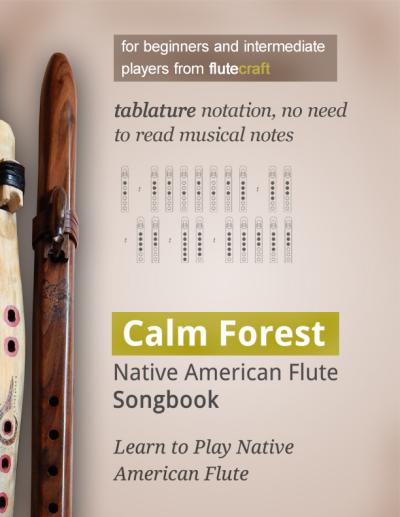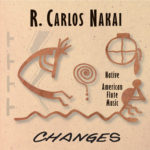On FluteCraft’s Facebook page, a reader named Sonny inspired me to write a word or two about improvising on Native American Flute. In his own words:
I believe people today are missing the whole scope of the NAF. What has happened to playing from the heart, trees, creeks and horizons?
It’s an interesting question. Well, I don’t know what exactly happened, but I do know what he means :). So how do you actually play “from the heart”, how do you improvise on Native American Flute? And do you really have to learn this?
Let’s answer the last question – do you really have to learn how to improvise on Native flute? The honest answer is: no. Not at all. Because in reality, you can play whatever you want. If you only want to play notated music, or things composed by others, that’s perfectly OK. I do this all the time when I just want to hear the flute, because for me, it’s fun.
Improvisation is an optional skill.
It’s Easier Than You Think
Teaching improvisation is difficult. Really, I’m not really sure if it’s even possible, but I can offer you a couple of advices.
- First, learn how to play the NAF. This is where the basics come into play. Learn how to control your breathing, how to make sounds with a NAF, and how to play the minor pentatonic scale in both directions.
- Second, play notated music a lot. You can take a look at my songbook, Calm Forest. The idea behind this is simple: you learn the notes, nearly subconsciously. By playing, you create connection between the neurons in your brain, and after some time, without actually realizing this, you know how each note of the flute sounds like. You don’t have to think about it, but your brain and your fingers just know this. This is just experience.
- Third, learn a simple technique of seeking inspiration in the world you see, so you know how to start.
Let’s move on.
Learn the Basics
Sonny said:
Too much attention is given to the scales.
I think it’s more about what you want to achieve. For example, if you want to learn to play NAF to record your music along with other instruments, then yes, scales and Western music theory are both very important (trust me, I compose orchestral music in Western style). Even if you just want to play solo, but want to add something too your music, like drums, or additonal “pads and atmospheres” (sustained electronic sounds), you need to learn music theory.
But if you want to just play NAF solo, just for yourself or your friends and family, without any additional elements, then you can limit yourself to the minor pentatonic scale. And you don’t have to read music notes, you just need to practice how to make these sounds on your flute.
The Native American flute is tuned to Minor Pentatonic scale. The five (sometimes six) finger holes are tuned in such way that playing them from bottom to top gives you minor pentatonic scale. This is an extraordinary scale.
Here’s a great video from World Science Festival, featuring Bobby McFerrin, in which Mr McFerrin demonstrates the pentatonic scale, take a look.
Minor pentatonic is like a genetic scale, embeded into our DNA. We all “know” it, we call “feel” it. It’s awesome! It’s not mystical, not spiritual, just scientific – a lot of genetics, evolution, and math. Putting my love of science, neurology and genetics aside, here’s the thing:
- If you keep playing the scale on your NAF for a couple of hours, you get so used to it that improvising becomes very simple and very natural.
Just play the scale, pick up a song book (like my Calm Forest, using only tablature), and play, practice. Then to go bed, have a good night sleep and your brain will create new connections between your neurons. Then wake up, practice some more and repeat this for a couple of days, or a few weeks (don’t forget to do other things, like living, obviously).
This is the practice part. After a few weeks (maybe days, or maybe months, after all we are all different), minor pentatonic on your flute will become very familiar, very “natural”.
Improvisation Based on the World Around You
The world around you isn’t flat. There are buildings, trees, mountains, various elements of different size. You can use it to create various songs. How so? Imagine your see a couple of trees in front of your. In many cases, if they’re a natural formation, they will have different height.
Use this. Play lower notes for shorter trees, and higher notes for taller trees.
Listen to my “Song of Five Spruce Trees” on Jamendo (it’s free!).
I made it with this technique. There were five trees that I could see from my home that were of various height. I just started playing on my flute, low notes for short threes, lower notes for even shorter threes, high notes for tall threes, higher notes for even taller threes. In a few minutes, the melody was done. Later on, I wrote it down, but at the time of composing, this was pure improvisation.
In the same way, you are surrounded by things that, as you look at them, present you with “curves” – short objects, tall objects. You can pick up something you see in your office, or behind the window, or you can google images of mountains and use these, too. After some time, you will figure out how to play in this way.
What about the rhythm?
Human beings have a natural thing for rhythm, so don’t worry about it too much. Just decide if you want to play slowly or speed things up a little, and “trust your guts”, you will pick up the rhythm naturally. Really, this is an inborn thing.
Improvisation From the Heart
Finally, we come to the last thing – improvisation from the heart, which cannot be taught, really. If you have enough practice with your flute, such improvisation becomes natural. Start on the note you feel like it’s the right one right now, and move on from there. Flow.
Improvisation is a powerful tool of “healing”. Healing, as in this strange thing that happens with your body on a chemical level, and physical level, and mental level. There is no spiritual stuff here, no healing energies, no New Age – just the emotional act of musical expression that does things to you: relaxing muscles, producing endorphins and other hormones, and doing all this scientific stuff that we know as the process of relaxation. And relaxation sometimes needs help. Playing and instrument is a great help, and Native American style flute is a simple instrument everyone can play. This makes is a powerful tool in your arsenal after a long day of work.
This is what I do – whenever I need to: after work, or when stressed, I pick up the flute and just start playing, choosing one of the notes at random and using my experience to construct improvised melodies as I see it fit, as I feel it, as I want it. Experience in this case is nothing special – I played a lot of melodies in my life, and my brain knows how all the notes sound, so I know which note I’m going to play next. This is not something to explain – this is something you learn over time, after playing tablatured melodies and songs.
The Most Important Suggestion
In the end, you have to remember this: play what you want to play. Don’t let anyone tell you what you and can’t play on your instrument. On Native American flute you can play traditional music, pop music, heavy metal, epic orchestral, anything you want! You can play for free, you can play for money. I even heard of business people who play Native American flutes after a long day at work and it helps them be more productive and more successful. But most of all, you can play because you want to. And this is the whole point.
If you have your own techniques for improvisation that you want to share with other readers, please post them in the comments below.
Don't forget to become a fan on Facebook and subscribe to new posts via RSS or via email.










 via EMAIL
via EMAIL